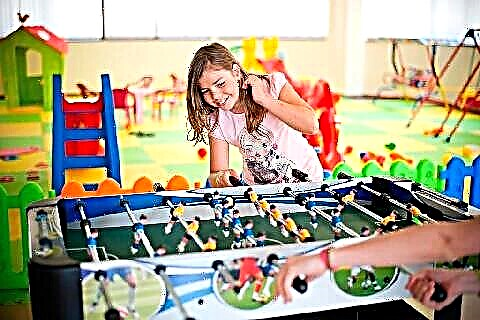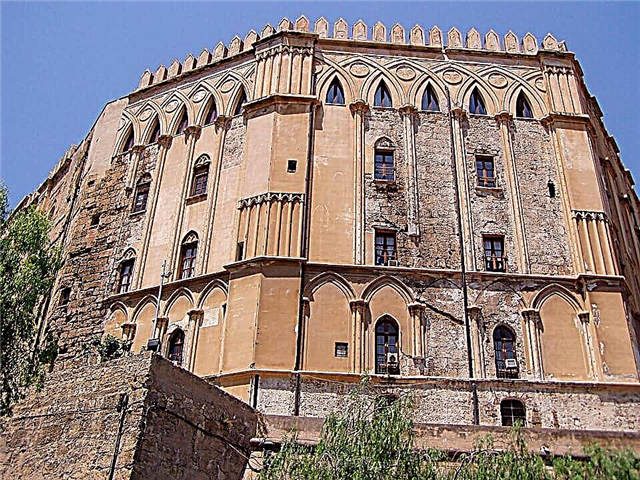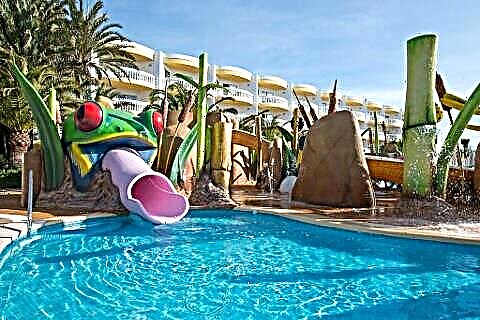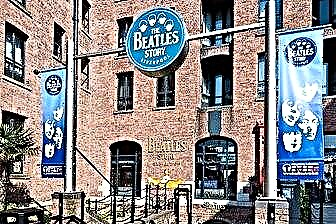Liverpool is worth visiting not only as the home of the incomparable "The Beatles", although it is undoubtedly the main reason for many travelers. The city is known for its large port, now converted into an art space, numerous sporting events and vibrant nightlife.
After the obligatory pilgrimage to Matthew Street and a trip to the "Beatles" Cavern Club, you should pay attention to the museums of the Albert Dock and a visit to the ancient English estate of Speck Hall. In these places you can learn a lot about the history and traditions of the city, plunge deeper into the atmosphere of the Tudor era. Finish the walk in Sefton Park or Anfield Stadium, where the next football league competitions will be held.

The best hotels and hotels at affordable prices.
from 500 rubles / day
What to see and where to go in Liverpool?
The most interesting and beautiful places for walking. Photos and a short description.
Albert dock
Closed dock, designed by engineer J. Hartley in 1846. For the 19th century, this was a rather bold decision - goods from ships went straight to the warehouse, bypassing the intermediate unloading links. Now the dock is used as an art space and an entertainment area. There are many museums, hotels, restaurants, bars, concert venues here. All in all, trivial storage facilities have turned out to be a good tourist attraction.

Cavern Club
The famous bar on Matthew Street, where the legendary band The Beatles performed. In the 70s. it was demolished by the decision of the city authorities, but then they came to their senses and rebuilt everything brick by brick. The bar of the club continues to serve excellent ales and perform young rock musicians. The walls of the institution are pasted over with photographs of the Liverpool Four; some personal belongings of the group members are kept here as museum exhibits.

Anfield stadium
A modern stadium with the highest category of 5 stars. The arena is home to the Liverpool football team. At the same time, by British standards, the capacity of the stadium is small, it is designed for 54 thousand fans, although during matches at least three times as many people want to watch the game. The arena was built in 1884 and was reconstructed and expanded three times during the 20th century.

Royal Life Building
An office building from the beginning of the 20th century, which is recognized as a historical monument and is taken under the protection of UNESCO (like the entire territory of the Liverpool port). The structure is known for the fact that reinforced concrete was used for the first time during its construction. The Royal Life Building towers adorn the watch dials 7.6 meters in diameter, which exceeds the size of London's Big Ben by as much as 60 cm. The clock was started at the time of the coronation of George V in 1911.

Cunard building
One of the administrative buildings on the territory of the Liverpool port, built during the heyday of the city. The structure was built in the period 1914-1917 from reinforced concrete according to the project of W.E. Willing and F.K.Fikness. Until 1960, the building was used as an office for CunardLine, a transatlantic passenger carrier. Since 2001, government offices have been located there.

Port of Liverpool Building
A building on the city waterfront, which is considered the symbol of Liverpool. The Port of Liverpool Building was built between 1903-1907. For 87 years, it has hosted the headquarters of the Mersey Docks and Harbor Board. In 1941, the building was bombed, but was quickly rebuilt with company funds. Several episodes of The Adventures of Sherlock Holmes were filmed inside the Port of Liverpool Building.

Liverpool Cathedral
The main Anglican temple of the city. The construction of the cathedral began in 1904 and was completed only in the 70s. XX century. The building looks quite impressive, the length of the facade is 188 meters, the height of the main nave is 36.5 meters, the bell weighs several tens of tons. Liverpool Cathedral is considered the largest Anglican cathedral in the world and the fifth largest temple in the rest of the Christian church.

Liverpool Metropolitan Cathedral
Cathedral of the Catholic Diocese. It was built between 1962 and 1967. for the needs of the growing Catholic flock. The fact is that since the middle of the 19th century, Irish immigrants have moved to Liverpool in droves because of the famine raging in their country. The Irish were mostly Catholics, so after a while they needed their own impressive church.

Museum "The Beatles"
The museum is located on the territory of the Albert Dock. The exposition is dedicated to the work of the legendary band The Beatles, whose success began at Liverpool concert venues. The museum was opened in 1990. Very quickly, his collection grew so much that he had to open a branch. Inside, visitors can see instruments, musicians' concert costumes, posters, photographs, lyrics, and more.

World museum
Natural science museum dedicated to the biological, archaeological, ethnological and physical history of our planet. The collection began to be collected in 1851; many of the exhibits are so unique that they have no analogues in other museums in the world. The library is located in the same building. Initially, the book collection occupied a separate room, but after 1860 it was housed in the monumental building of the museum.

Merseyside Maritime Museum
The collection of the museum occupies several premises of the Albert Dock, it is completely devoted to shipping, the history of ships and ports. Models of English ships are on display in Merseyside. Some samples are made on a reduced scale, others, on the contrary, are made in full size. Here you can see luxury transatlantic liners, pirate galleons, passenger ferries and old galleys.

Liverpool Museum
The modern museum on the embankment of the River Mersey, which opened in 2011. The building of modern architecture was designed by the Danish town planning office. The museum exposition is dedicated to the history of the city, as well as the role it played in the life of the country. In 2012, by decision of the Council of Europe, the Liverpool Museum was recognized as the best museum of the year. The funds contain about 6 thousand exhibits.

International Slavery Museum
The exposition began work in 2007. It is entirely devoted to the phenomenon of slavery as a sad and shameful phenomenon in human history. Among the exhibits there are maps of the routes of the slave trade, photographs and documents telling about the scale of this "business". Also, a large part of the collection acquaints visitors with the culture of the peoples of African countries, from where slaves were mainly delivered.

Empire Theater
The theater building was erected in 1925 on the site of the old city opera. Initially it belonged to the private company "Moss Empires", but in the 70s. the city authorities bought the theater, after which a large-scale reconstruction began. The stage is designed for about 3000 seats, and invited bands often perform on it. In addition to classics, the Empire Theater also hosts contemporary musicals.

St. George's Hall
A monumental building that combines a concert venue and an exhibition center. The building was erected in the middle of the 19th century according to the project of H. Elmes. Once upon a time, Charles Dickens read to the public within the walls of St. George's Hall, and the Beatles drummer Ringo Starr performed on the roof. From the outside, the building resembles a massive and pompous antique temple, decorated with a powerful colonnade and decorated with bas-reliefs.

Walker Art Gallery
City Art Gallery, which houses works of art created in the period of the XIV-XX centuries. The museum is considered one of the most significant in the UK for its invaluable cultural heritage. The gallery was opened in 1877, the name was given in honor of E.B. Walker - an industrialist and philanthropist who allocated funds for the construction. The building was erected in a calm neoclassical manner.

Tate Liverpool
Gallery of Contemporary Art, opened in 1988 on the territory of the Albert Dock. Tate Liverpool is one of the most visited museums in the city, over several decades its funds have grown to 60 thousand exhibits, although initially imported collections were exhibited here. The museum began as the National Gallery of British Art, but soon the administration, having caught the modern mood, decided to create a space for creative people and protect them from the attacks of bigots.

Bluecot Chambers
The cultural center, located on the territory of a historical building from 1717-18. the buildings. Bluecote Chambers has always hosted exhibitions of contemporary artists and various performances. Also, lectures, scientific debates, poetry evenings and all kinds of meetings are often held here. The Arts Center has been housed in a building since the beginning of the 20th century, before that there was a public school built by Captain B. Blundell.

Town hall
City Hall, built in the 18th century by J. Wood in a mixed Gothic and neoclassical style. The interior is decorated with original Art Deco elements and is decorated with lamps, mosaics and paintings. It should be noted that many details of the interior decoration have remained intact since the time of construction. The city council sits in the building, at a certain time you can go inside with a guide.

Victoria Building
The structure was built for the University of Liverpool in 1892. It housed classrooms, living rooms and a library. In 2008, the building was converted into a museum. A shop and a restaurant were located on the ground floor, the rest of the space was given over to the exposition. The Victoria Building is a striking representative of the picturesque "Victorian Gothic", the building was erected from red brick.

Lime Street train station
The station was built in 1836 and became the first station on the Liverpool-Manchester railway line. In 1849, a new building was erected for the station, part of which has survived to this day. In 1867, a modern building appeared, which was completed and reconstructed several times over the next years. The capacity of the station is more than 15 million people a year, and it is constantly increasing.

Radio City Tower
Radio and TV tower with an observation deck, reaching a height of 138 meters. The tower was erected in 1969, the opening took place in the presence of Elizabeth II. It was assumed that the tower would be used as a ventilation shaft, but these plans did not materialize. For a long time, the tower was not used at all, until in 1999 it was reconstructed for broadcasting purposes. There are also conference rooms and offices on the territory.

Matthew Street
Small city street, which became famous thanks to "The Beatles". In addition to the legendary Cavern Club, where the musicians began their careers, there are dozens of bars styled in the 1960s. and using the "Beatles" popularity. All tourists rush straight to Matthew Street after arriving in Liverpool, and then go to explore other city attractions.

Speck Hall
A Tudor country mansion built in the 16th century. The building has almost completely retained its appearance over the past centuries, only individual annexes and facade elements have changed. Representatives of three families managed to live on the territory of the Speck Hall, in the 19th century it was transferred to public use due to the lack of heirs. The house has secret passages where Catholic priests could hide during the persecution.

Sefton Park
Liverpool City Park, home to the Peter Pan statue, has a pond with a boat station and a gorgeous glass-roofed winter garden called Palm House. The building often hosts performances by orchestras and jazz bands, and stand-up comedians are also regular guests of the site. There is a lot of space for walking and relaxation in Sefton Park; playgrounds are organized in special places.












